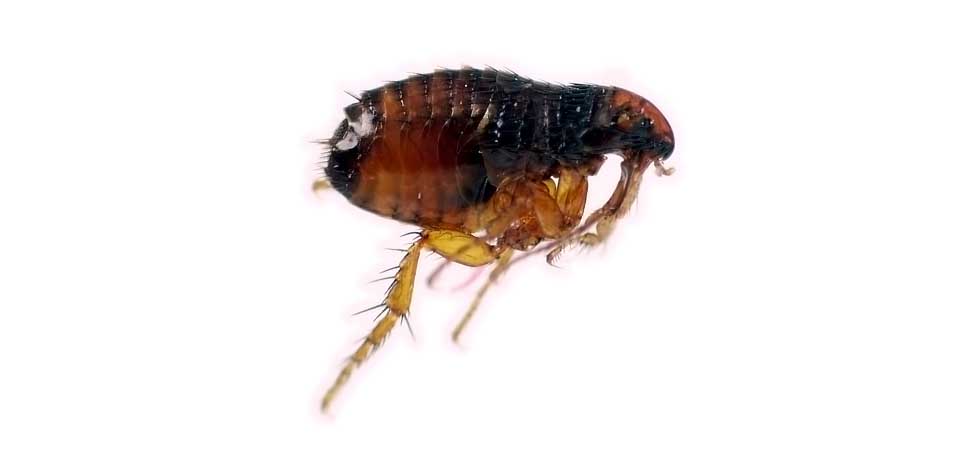FLEA FACTS | IDENTIFICATION & CHARACTERISTICS
There are approximately 2,000 species of fleas worldwide with nearly 300 of these varieties of which you can find found in North America. Fleas are wingless external parasites with mouthparts that have adapted to allow the flea to pierce skin and suck blood. They have six legs, with the long hind legs which are very well adapted for jumping. A flea can jump over 7” vertical. Fleas feed on the blood of mammals and birds, and thrive in warm, humid environments. The two most common type of fleas found in our region are the cat flea (Ctenocephalides felis) and the dog flea (Ctenocephalides canis). Both belonging to the order Siphonaptera these are the most abundant and widespread species of flea found in the world today. Dogs actually play host to the cat flea just as cats are a suitable host for dog fleas. The appearance of cat fleas and dog fleas closely resemble one another. An adult flea is a dark, shiny brown or black, and approximately usually 1-2mm long. Fleas has an extremely thin, flat body which can make them difficult to see. Fleas undergo a complete metamorphosis which includes 4 stages of development (egg, larvae, pupa and adult stage). An adult flea must take a blood meal in order to reproduce.

FLEA HABITS | DAMAGE, FOOD SOURCE & REPRODUCTION
Fleas feed on the blood of a host animal, often cats and dogs. Fleas can be transferred by way of birds or rodents as well. Fleas can even bite humans, however they will not infest people in the way they may infest our pets or other mammals. To enable reproduction the adult flea must take a blood meal. A female flea will produce and deposit 40-50 eggs into the host animal every day. Eggs can take a few days to a few weeks to develop. They hatch when conditions are favorable for the larvae stage. Emerging larvae develop over the next two to three weeks by consuming previously digested blood, commonly referred to as “flea dirt”. Once the conditions are suitable the larvae will prepare a cocoon which will continue the flea’s progression into the pupae stage. The pupae stage is the final developmental stage before an adult flea will emerge. The cocoon acts as a protective barrier from virtually all external influences (including pesticides) and can be sustained for weeks or even months and in the rarest of cases, even years. The final stage is the adult flea, and is triggered by presence of vibrations, raising levels of carbon dioxide due to host activity in the immediate area. The adult flea will only occur once the presence of a potential host is known to the flea. Once the adult flea emerges it will continue the cycle of feeding and reproduction within a few hours. During the winter months fleas survive as adults on cats, dogs or other mammals. Fleas also survive the cold as within the protected enclosure of the pupae stage as adults (not yet emerged). Fleas do not cause damage to a structure but are capable of transmitting disease or other parasites and infections to the host. Fleas have long been suspected as the agent of transmission for the bubonic plague. Transmission of tapeworm is possible if a person were to accidentally ingest an infected flea, or come into contact with infected feces. People can also experience bites which often results in a small rash surrounding bite marks with itchy skin.

EVIDENCE OF FLEAS | SIGNS OF INFESTATION & WHAT TO LOOK FOR
The most obvious sign of a flea problem on your pet would be noticing an excessive amount scratching, biting or licking at the skin, caused by discomfort of flea activity as the adult fleas continue to bite the animal. Upon closer inspection of the pets hair and skin you may find droppings, also commonly referred to as “flea dirt”. You may even find eggs on the animal, or in the pets kennel or bed area. More extreme cases can result in allergic dermatitis, loss of hair, scabs or sore spots on skin. If you find fleas or evidence of fleas present on your pet you should contact your veterinarian to discuss treatment options for your pet in conjunction with your efforts to control them in the home.

CALL ALERT #1 FOR CONTROL & PREVENTION OF FLEAS
Although there are many do-it-yourself products on the market (some of which do kill fleas) these products often prove ineffective at handling a persistent flea problem. Effective control of fleas often requires the help of a pest management professional. Alert #1 is your local pest management professional.
The technicians at Alert #1 have many years of experience built upon the successful control of fleas in and around the home. We understand the the habits of fleas in our area, and know how to provide the most appropriate and effective solution for any situation.
The most successful and long term strategies for control typically involve a coordinated effort between the occupants of the home and the efforts of the pest management professional. Upon identifying an infestation of fleas the home must be cleaned thoroughly which typically involves vacuuming, laundering and decluttering an area to prepare for treatment. The precise application of pesticide sprays should be determined by the pest management professional, who will also make the appropriate recommendations relevant to the control effort.
Give the professionals a call today, and let one of our friendly experts help with your flea problem. We offer a free inspection service for your home, will make the appropriate recommendations and if needed, help you by resolving the issue directly with one of our guaranteed services.
